Panasonic Lumix DMC-G1 Review
Review Date: November 25th 2008
Author: Mark Goldstein
Leave a comment about this Review
|
Image Quality
All of the sample images in this Review were taken using the 12M Fine JPEG image size option, which gives an average image size of around 5Mb.
The Panasonic Lumix DMC-G1 produced images of very good quality during the review period. The 17.3x13mm Four Thirds, 12 megapixel sensor used in the Panasonic Lumix DMC-G1 produces noise-free images at ISO 100 and 200, with limited noise starting to appear at ISO 400. ISO 800 exhibits quite visible noise and loss of fine detail, and ISO 1600 and 3200 are even noisier (the latter setting is almost unusable). The G1 dealt extremely well with chromatic aberrations, with limited purple fringing effects appearing only in high contrast situations. The pop-up flash worked well indoors, with a little red-eye and good overall exposure. The night photograph was excellent, with the maximum shutter speed of 60 seconds allowing you to capture plenty of light. Anti-shake is a feature that sets the DMC-G1 apart from its competitors and one that works very well when hand-holding the camera in low-light conditions or when using the telephoto end of the zoom range. Macro performance with the standard 14-45mm kit lens is poor, allowing you to focus as close as 30cms away from the subject. The images were a little soft straight out of the camera at the default sharpening setting and ideally require further sharpening in an application like Adobe Photoshop, or you can change the in-camera setting if you don't like the default results.
Noise
There are 6 ISO settings available on the Panasonic Lumix DMC-G1 which you can select at any time if the camera is in one of the creative shooting modes. There is virtually no discernible noise at the slowest settings of ISO 100 and 200, and ISO 400 also looks fine, with some noise creeping in. More obvious noise and slight loss of detail is apparent at ISO 800, particularly in the shadow areas, and at the fastest settings of ISO 1600 and particularly ISO 3200, image quality has deterioated a lot. Here are some 100% crops which show the noise levels for each ISO setting:
ISO 100 (100% Crop) |
ISO 200 (100% Crop) |
 |
 |
ISO 400 (100% Crop) |
ISO 800 (100% Crop) |
 |
 |
ISO 1600 (100% Crop) |
ISO 3200 (100% Crop) |
 |
 |
File Quality
The Panasonic Lumix DMC-G1 has 2 different JPEG image quality settings available, with Fine being the highest quality option. Here are some 100% crops which show the quality of the various options, with the file size shown in brackets.
10M
Fine (5.02Mb) (100% Crop) |
10M
Normal (2.21Mb) (100% Crop) |
 |
 |
Sharpening
Here are two 100% crops which have been Saved as Web - Quality 50 in Photoshop. The right-hand image has had some sharpening applied in Photoshop. The out-of-the camera images are a little soft at the default sharpening setting, and benefit from further sharpening in a program like Adobe Photoshop. You can also change the in-camera sharpening level by tweaking the Film Mode, with five different settings available.
Original
(100% Crop) |
Sharpened (100% Crop) |
 |
 |
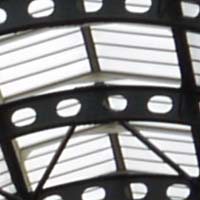 |
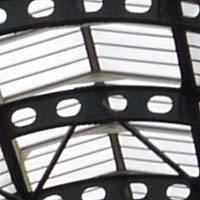 |
Chromatic Aberrations
The Panasonic Lumix DMC-G1's standard 14-45mm kit lens dealt extremely well with chromatic aberrations during the review, with very limited purple fringing present only around the edges of objects in certain high-contrast situations.
Chromatic
Aberrations
1 (100% Crop) |
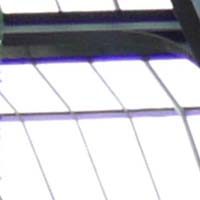 |
Macro
The Panasonic Lumix DMC-G1 standard 14-45mm kit lens allows you to focus on a subject that is 30cm saway from the camera when the lens is set to any focal length. The first image shows how close you can get to the subject (in this case a compact flash card). The second image is a 100% crop.
Macro |
Macro (100% Crop) |
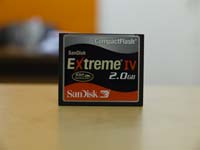 |
 |
Flash
The flash settings on the Panasonic Lumix DMC-G1 are Auto, Auto/Red-eye Reduction, Forced Flash On, Slow Sync./Red-eye Reduction and Forced Flash Off. These shots of a white coloured wall were taken at a distance of 1.5m.
Flash Off - Wide Angle (28mm) |
Auto Flash - Wide Angle (28mm) |
 |
 |
Flash Off - Telephoto (90mm) |
Auto Flash - Telephoto (90mm) |
 |
 |
And here are some portrait shots. As you can see, both the Flash On setting or the Red-Eye Reduction option caused a small amount of red-eye.
Flash On |
Flash On (100% Crop) |
 |
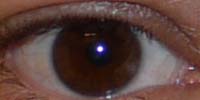 |
Flash - Red-Eye Reduction |
Flash - Red-Eye Reduction (100% Crop) |
 |
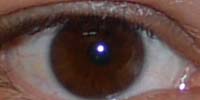 |
Night Shot
The Panasonic Lumix DMC-G1 maximum shutter speed is 60 seconds and there's also a Bulb option for exposures up to 4 minutes long, which is excellent news if you're seriously interested in night photography. The shot below was taken using a shutter speed of 10 seconds at f/8 at ISO 100. I've included a 100% crop of the image to show what the quality is like. The camera takes the same amount of time again to apply noise reduction, so for example at the 15 second setting the actual exposure takes 30 seconds.
Night Shot |
Night Shot (100% Crop) |
 |
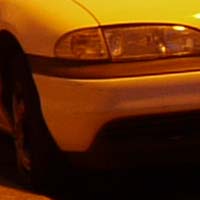 |
|
![]() PhotographyBLOG
is a member of the DIWA
organisation. Our test results for the Panasonic Lumix DMC-G1 have
been submitted to DIWA
for comparison with test results for different samples of
the same camera model supplied by other DIWA
member sites.
PhotographyBLOG
is a member of the DIWA
organisation. Our test results for the Panasonic Lumix DMC-G1 have
been submitted to DIWA
for comparison with test results for different samples of
the same camera model supplied by other DIWA
member sites.
